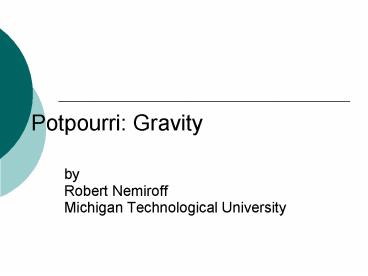Potpourri: Gravity - PowerPoint PPT Presentation
1 / 12
Title: Potpourri: Gravity
1
Potpourri Gravity
- by
- Robert Nemiroff
- Michigan Technological University
2
Physics X About This Course
- Officially "Extraordinary Concepts in Physics"
- Being taught for credit at Michigan Tech
- Light on math, heavy on concepts
- Anyone anywhere is welcome
- No textbook required
- Wikipedia, web links, and lectures only
- Find all the lectures with Google at
- "Starship Asterisk" then "Physics X"
- http//bb.nightskylive.net/asterisk/viewforum.php?
f39
3
Birkhoff's Theorem
- A very useful theorem that leverages spherical
symmetry in General Relativity. Two common
applications - Outside a spherically symmetric mass distribution
(hence not rotating), the solution is always the
Schwarzschild metric. - useful for ignoring stellar pulsations
- Inside a spherically symmetric mass shell, the
gravitational "field" will vanish. - useful for ignoring the outside universe
4
Virial Theorem
- A relation between the average total kinetic
energy of a system of particles (Ktot) and the
average potential energy of the particles (Vtot).
For Newtonian gravity - 2 Ktot - Vtot
- Useful for determining the amount of dark matter
in clusters of galaxies (for example). Theorem
can apply to even one particle.
5
Gravothermal Catastrophe
- The center of a gravitationally bound system of
particles will heat up at it gravitationally
collapses. For those particles, the increase in
energy comes from a conversion of potential
energy to kinetic energy. - However, some other particles will be thrown out
from the center and will "cool down". - Runaway For sufficiently condensed systems of
particles acting gravitationally, the center will
be unstable to becoming increasingly dense and
hot, since that will decrease system entropy. A
single temperature will no longer describe the
system.
6
Gravitomagnetism
- A gravitational force that complements standard
gravity like magnetism complements standard
electric force. - Predicted by General Relativity (and even other
gravitational theories that predate GR). - A small effect -- it is being tested by Gravity
Probe B, although these results have not yet been
announced.
7
Gravitomagnetism
- Typically a very small effect.
- If two wheels are spun on a common axis, their
mutual gravitational attraction will be
(slightly) greater if they spin in opposite
directions. - A ring rotating about its minor axis (a circle
inside the ring) will accelerate matter through
the ring while that matter feels no
acceleration. - Earth's gravitomagnetic acceleration at the
Equator is about 10-7 g. - Cannot be used to create a perpetual motion
machine.
8
Frame Dragging
- The General Relativity expected effect that
rotating objects drag spacetime around with them. - A gravitomagnetic effect.
- Also known as the Lens-Thirring Effect
- When near a massive rotating object, you may feel
that you are not rotating with respect to the
universe, even though you can see that you are. - Typically a small effect.
9
Frame Dragging
- FD has never been measured in the laboratory
- very difficult to do
- Would rotating a bucket create the same effect as
rotating the entire universe? - Might be relevant to jets emitted from active
galaxies.
10
Gravitational Radiation
- Emitted by accelerating masses in GR, in analogy
to electromagnetic radiation emitted by
accelerating charges. - Acceleration must be non-spherically symmetric.
- Very weak compared to common photon energies.
- Not yet directly detected on Earth.
- Ongoing searches include LIGO
11
Gravitational Radiation
- Strongly emitted by massive and rapidly changing
astronomical objects. - Supernovas (we know)
- Gamma ray bursts (we think)
- Steadily emitted by decaying binary star systems
- binary pulsar's orbital decay can be attributed
to gravitational radiation to high accuracy
12
Gravitational Radiation
- moves at the speed of light.
- has wavelength and frequency like light lambda
c f. - A passing polarized gravitational wave would have
this effect on a ring of particles































